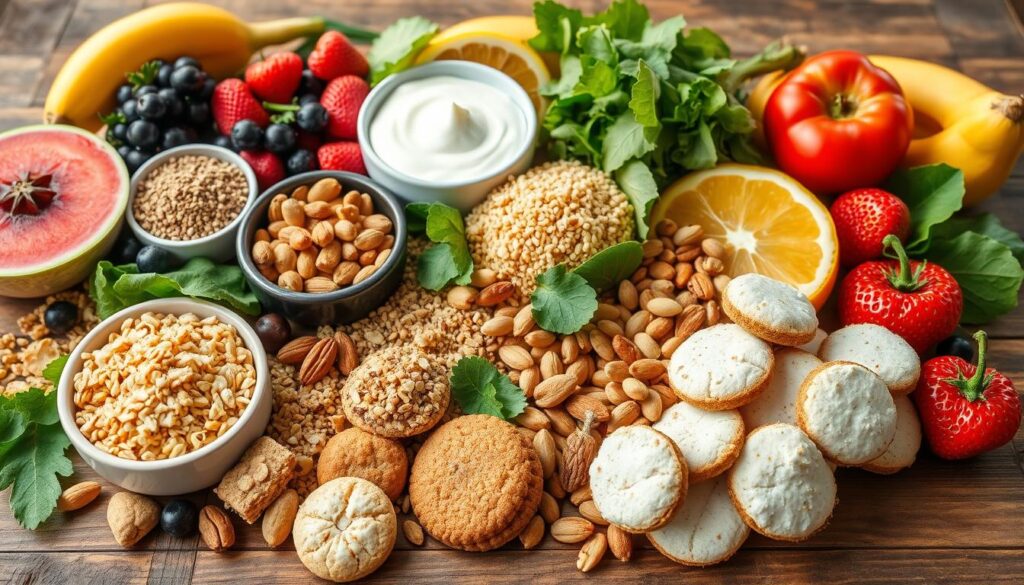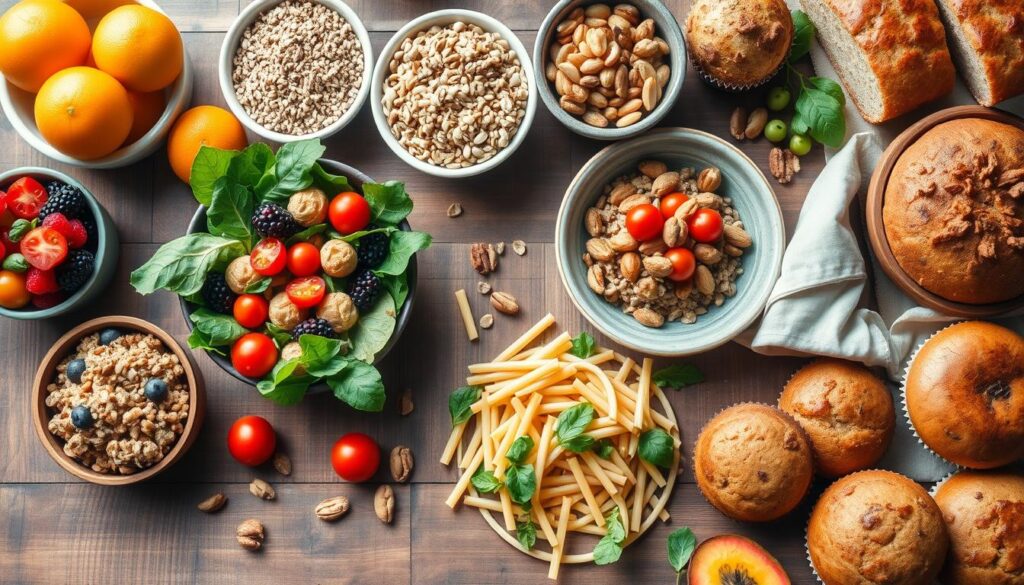Starting a gluten-free life can change everything for those with celiac disease or gluten sensitivity. This guide will help you make a gluten free diet plan that’s good for your health. It also includes tasty, wheat-free recipes to enjoy.
If you’re new to gluten-free or want to improve your plan, this guide is for you. It will help you manage your diet and live well on a celiac disease management path.
Key Takeaways
- Gluten-free diets are key for managing celiac disease, gluten sensitivity, and wheat allergy
- Gluten-free diets are getting more popular, but we need more research
- It’s important to pay attention to what you eat on a gluten-free diet
- Gluten-free diets can have 1,176 to 1,224 calories a day
- The gluten-free market has grown a lot, reaching $4 billion
Understanding Gluten and Its Effects on Health
Gluten is a protein found in wheat, barley, rye, and spelt. It makes dough sticky, helping bread rise and feel chewy. But for some, gluten can cause bad stomach problems and even harm their immune system.
What is Gluten and Where is it Found?
Gluten is in many foods like bread, pasta, and cereals. It’s also in sauces, dressings, and some medicines. Knowing where gluten is helps those who need to avoid it.
Common Symptoms of Gluten Sensitivity
- Diarrhea or constipation
- Abdominal pain and bloating
- Fatigue and weakness
- Headaches and migraines
- Skin rashes or eczema
- Unexplained weight loss
Different Types of Gluten-Related Conditions
Celiac disease is a well-known condition where the body attacks gluten. It affects about 1% of people in the West. Those with celiac must avoid gluten to protect their small intestine.
Non-celiac gluten sensitivity (NCGS) affects 0.6-13% of people. It causes stomach problems but doesn’t harm the immune system like celiac does. Some people have a wheat allergy, reacting to wheat but not gluten.
“Gluten can trigger a severe autoimmune response in some people or cause other unpleasant symptoms.”
Who Should Follow a Gluten Free Diet Plan
If you have celiac disease, you must avoid gluten. This is to stop damage to your intestines and prevent nutrient loss. Gluten can harm the lining of your small intestine and block nutrient absorption.
People with non-celiac gluten sensitivity (NCGS) might also find relief by eating less gluten. NCGS has symptoms similar to celiac disease. It involves the immune system. Those with a wheat allergy should also avoid wheat, which means following a gluten-free diet.
Before starting a gluten-free diet, talk to a doctor. It’s important for diagnosing celiac disease or other conditions. Gluten ataxia, for example, affects nerves and can cause muscle problems. This is due to an immune reaction to gluten.
| Condition | Prevalence | Dietary Recommendation |
|---|---|---|
| Celiac Disease | Affects at least 1% of the population in the Western world | Strict gluten-free diet for life |
| Non-Celiac Gluten Sensitivity (NCGS) | Affects around 0.6%–13% of people | Reducing gluten intake may provide relief |
| Wheat Allergy | Approximately 65% of children outgrow it by age 12 years | Avoid wheat products, which often means a gluten-free diet |
| Gluten Ataxia | Accounts for approximately 15% of all ataxia diagnoses | Strict gluten-free diet may help manage symptoms |
It’s key to talk to a doctor before starting a gluten-free diet. They can make sure you get the right diagnosis. They can also help with dietary changes and watch your health and nutrition.
Foods to Avoid on a Gluten-Free Diet
Living gluten-free can be hard. Gluten is in many foods, like wheat, barley, and rye. Knowing where gluten hides is key to a healthy gluten-free diet.
Hidden Sources of Gluten
Gluten is in places you might not expect. It’s in sauces, condiments, and some meds. Here are some common places to find gluten:
- Soy sauce
- Salad dressings
- Marinades and gravies
- Processed meats like deli meat and sausages
- Certain over-the-counter and prescription medications
Common Ingredients to Watch For
Look closely at ingredient lists for these gluten-containing items:
- Wheat, barley, rye, and triticale
- Malt, including malt vinegar and malt flavoring
- Brewer’s yeast
- Farina, semolina, and durum flour
Cross-Contamination Risks
Gluten-free and gluten foods touching can be a big problem. This is especially true for those with celiac disease or gluten sensitivity. To avoid this:
- Don’t use the same surfaces, utensils, and tools for gluten foods.
- Choose places that only serve gluten-free foods when eating out or getting takeout.
- Always check food labels to make sure they are gluten-free.
By knowing where gluten hides and being careful with what you eat, you can live a wheat-free and grain-free life. You can enjoy lots of gluten-free foods and recipes.
Safe and Nutritious Gluten-Free Foods
Following a gluten-free diet doesn’t mean you have to give up taste or nutrition. There are many healthy, naturally gluten-free foods. These include fresh fruits and veggies, lean proteins, and dairy products. They are safe and full of important nutrients.
Gluten-free grains like rice, corn, quinoa, millet, and buckwheat are great for gluten-free baking tips and wheat-free recipes. Nut flours like almond and coconut can replace wheat flour in baked goods. Always check labels to make sure they are gluten-free.
Fruits, veggies, beans, nuts, eggs, lean meats, and fish are naturally gluten-free. They are a good base for your meals. Dairy products like milk, yogurt, and cheese are also safe, unless you have a dairy intolerance.
| Nutrient | Importance on a Gluten-Free Diet |
|---|---|
| Iron | Helps prevent anemia, which can be common in those following a gluten-free diet. |
| Calcium | Supports bone health, which may be impacted by nutrient malabsorption on a gluten-free diet. |
| Fiber | Promotes healthy digestion and can help offset constipation sometimes experienced on a gluten-free diet. |
| B Vitamins | Important for energy production and nerve function, as some gluten-free diets may lack adequate B vitamin intake. |
With a little creativity and focus on nutrition, you can enjoy many delicious gluten-free meals. These meals support your health.

“Following a strict gluten-free diet can significantly improve symptoms and reduce health risks associated with gluten-related disorders.”
Creating Your Personalized Gluten Free Diet Plan
Creating a gluten-free diet plan is all about meal planning and prep. Plan your meals for the week and get the right gluten-free foods. This way, you can eat well and avoid gluten by mistake.
Using meal prep can also make your gluten-free life easier. It helps you stay on track and saves time.
Weekly Meal Planning Strategies
Planning meals ahead is crucial for a gluten-free diet. Spend some time each week planning breakfast, lunch, and dinner. Choose foods that are naturally gluten-free and full of nutrients.
This keeps you organized, saves time, and stops you from eating gluten when you’re in a hurry.
Shopping List Essentials
Make sure to get these gluten-free foods when you shop:
- Fresh fruits and vegetables
- Gluten-free grains like rice, quinoa, and buckwheat
- Lean proteins like chicken, fish, and eggs
- Nuts, seeds, and legumes
- Certified gluten-free baking mixes and flours
- Gluten-free condiments, sauces, and dressings
Meal Prep Tips and Tricks
Here are some meal prep tips to make your gluten-free diet easier:
- Cook extra gluten-free grains like brown rice or quinoa for the week.
- Make big batches of gluten-free proteins like roasted chicken or baked tofu. Use them in different meals.
- Have gluten-free snacks ready, like fresh fruit, veggie sticks, and trail mixes.
- Freeze gluten-free soups, chilis, and casseroles for quick meals.
Plan ahead, stock up on gluten-free foods, and use smart meal prep. You’ll be on your way to a great gluten-free lifestyle.
Navigating Nutrition on a Gluten-Free Diet
Starting a gluten-free lifestyle is great for those with celiac disease or gluten sensitivity. But, it’s key to plan well to get all the nutrients. Whole grains give us fiber, iron, and B vitamins, which might be missing in a grain-free diet.
To keep your diet balanced and healthy, add foods like quinoa, brown rice, and gluten-free products with added nutrients. Talking to a registered dietitian is very helpful. They can guide you on managing celiac disease and meeting your nutritional needs.
Also, watch what you eat from gluten-free products. Some might have more fat and sugar. Always check the labels and choose wisely. With a careful approach to your gluten-free lifestyle, you can eat well and avoid unhealthy foods.
| Nutrient | Importance in a Gluten-Free Diet | Good Sources |
|---|---|---|
| Fiber | Essential for digestive health and blood sugar regulation | Quinoa, brown rice, gluten-free oats, beans, lentils |
| Iron | Crucial for preventing anemia, which can be common in those with celiac disease | Spinach, lentils, fortified gluten-free cereals, pumpkin seeds |
| B Vitamins | Support energy metabolism and nervous system function | Nutritional yeast, gluten-free whole grains, leafy greens, eggs |
Focus on eating whole, nutrient-rich foods. Also, get advice from health experts. This way, you can enjoy a gluten-free lifestyle and keep your body healthy.

“Adopting a gluten-free diet thoughtfully can help maintain a healthy, balanced diet and avoid processed gluten-free options.”
Eating Out and Social Situations
Following a gluten-free diet can be tricky when eating out or at social events. But, with some planning and talking, you can find gluten-free places to eat. You can also enjoy social events while sticking to your diet.
Restaurant Guidelines
Before you go out to eat, look up menus online. Then, call the restaurant to ask about gluten-free choices. Tell the staff about your diet and watch out for foods that might mix with gluten.
Many places now have gluten-free menus or mark gluten-free foods. This makes it easier to pick what you want to eat.
Social Event Strategies
At social events, bring a gluten-free dish to share. This way, you know you have something safe to eat. It also lets others try gluten-free food.
Also, ask about the menu before the event. Talk to the host to make sure they can offer something you can eat.
Travel Tips for Gluten-Free Living
Traveling gluten-free takes some planning, but it’s doable. Bring gluten-free snacks and look up places to eat before you go. Knowing a few words in the local language helps when you’re eating out.
Stay ready and talk about your diet, and you can enjoy many dining and social experiences. Always put your health first.
“Eating out on a gluten-free diet is all about being prepared, communicating your needs, and finding creative solutions. With a little effort, you can enjoy the same dining experiences as everyone else.”
Conclusion
Following a gluten-free diet is key for those with celiac disease. It also helps those with non-celiac gluten sensitivity or wheat allergy. Starting a gluten-free life might seem hard, but with the right steps, it’s doable.
Seeing a doctor or a dietitian can guide you. They help you understand celiac disease management and meet your nutritional needs. Also, knowing about new gluten-free products and recipes makes eating fun and healthy.
Being dedicated and positive helps you succeed on a gluten-free diet. You can try new foods, find friends who support you, and focus on being healthy. Enjoy this journey towards a gluten-free life.


A Life-Changing Experience with This Weight Loss Supplement (Nagano Tonic)
I’ve always struggled with finding a weight loss solution that actually works for me. Like many, I’ve tried numerous diets, exercise routines, and supplements over the years—some worked for a short time, but nothing ever gave me long-term results. That was until I decided to try the weight loss supplement I found : Link to the Supplement.
From the moment I started using it, I noticed a difference. Not only did I feel more energized, but my cravings also became more manageable. The best part? I started seeing results much quicker than I anticipated! Over the course of just a few weeks, I noticed a significant reduction in belly fat and overall weight loss that I hadn’t been able to achieve before.
What makes this supplement stand out from all the others I’ve tried is how it supports me in my daily routine without any jitters or energy crashes. I’m able to stay focused and motivated, which has made it easier to stay on track with my diet and exercise plan.
This product truly exceeded my expectations, and I feel more confident and healthier than ever before. If you’re struggling with your weight loss journey like I was, I highly recommend giving this supplement a try. It’s been a game-changer for me, and I’m sure it can work wonders for you too!
Contant Them on email .. tonicnagano50@gmail.com
I’ve tried so many weight loss products over the years, but nothing worked like this supplement! Since I started using it, I’ve noticed a big difference in my energy levels and appetite control. In just a few weeks, I’ve lost weight and feel so much better. It’s been easy to stick with, and the results speak for themselves. Highly recommend this to anyone looking to make a real change!
wasn’t sure what to expect, but this weight loss supplement has really impressed me! After just a few weeks of use, I’ve already dropped a few pounds and feel more motivated to stay active. It’s helped curb my cravings and boosted my energy throughout the day. I’m excited to keep going and see even better results. Definitely worth trying!
Reach them on tonicnagano50@gmail.com
I was skeptical at first, but this supplement has truly made a difference in my weight loss journey. I’ve lost weight without feeling deprived or sluggish. My cravings are under control, and I feel more confident in my body. It’s easy to incorporate into my daily routine, and the results speak for themselves. I’m so glad I gave it a try!
Thanks David, i do use the link to make my purchase. you can get too here http://surl.li/iasppy
This Nagano Tonic has been amazing! In just a few weeks, I’ve lost weight, feel more energized, and my cravings are under control. Highly recommend it!
Thats the link to purchase http://surl.li/iasppy